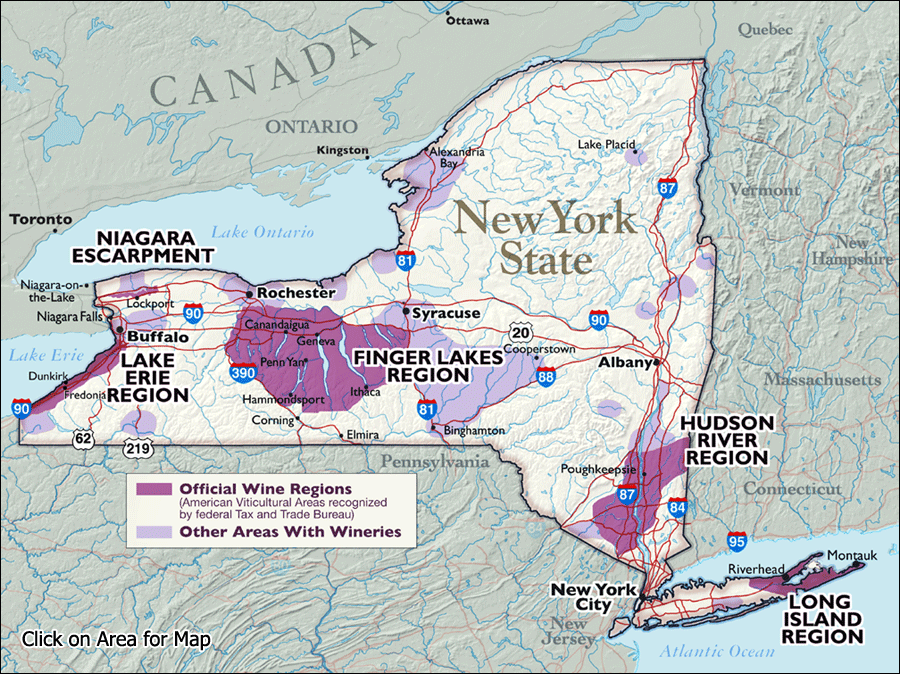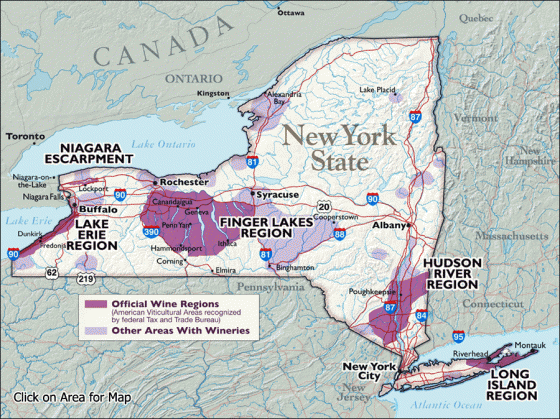In a 2004 speech on his educational programs, President Bush decried the “soft bigotry of low expectations” by the opposition party. The worthy phrase resonated with many. I wondered about such expectations in regard to New York wines, and how our wine industry would react if a mirror were held up to its wines and the reflection said “it’s great…for what it is…”
That stinging phrase, “for what it is…” is the comment that sinks and supplants the “world class” argument every time, and I’ve tried to count how often I’ve heard it over the years.
As if further explanation were even required at this point, let me posit the possibility of a Pauillac or a Volnay being described the same way — not likely. But this malignant axiom gets attached to places like Chile and Argentina, though less so recently, and to more obscure places who exist in the shadow of more reputable neighbors. Minor appellations like the Cotes de Bourg, Languedoc, Anjou, Toro, Rufina, Michigan and Niagara…even whole grape varieties aren’t immune to similar treatment.
Expectations are naturally lowered to meet the potential of these weaker communes, right?
What inspires a sommelier or other taste-making wine professional to put a Cheverny, Grüner Veltliner, Verdichio or a Navarra by the glass? Wines like this are obscure but of high quality they’ll tell you, and they are bringing their customers an experience and a value that they would certainly have little chance of otherwise finding. Correct on all counts. What do they see when they look at our home state’s truly fine wines? I’m not going to dig up the old chestnut of Loire restaurants selling only Loire wines and Bordeaux restaurants selling only Bordeaux wine. We know that New York is cosmopolitan to the utmost, and not in the least bit provincial. Besides, I’d even be willing to suggest that our placement near to the Big Apple is an unfair advantage we haven’t even exploited fully.
So why are our wines termed “great…for what it is…” so often? Are expectations lowered for New York wines, like other minor regions?
I believe our circumstance is self-inflicted. We (often) fail to support our legitimate claims to greatness by failing to meet our customers’ expectations of quality versus price. Unstable and illogical pricing is further compounded by a varied, random mix of world-class wines with inferior wines. That is auxiliary to a difficult-to-fulfill and difficult-to-maintain supply chain. Further, we haven’t fully embraced the tools that bring us closer to the end-user of our product (like social media) and we’re not evolving as quickly as other industries.
By simply attempting to meet our customers’ expectations at a business level, fiscally and logistically, we start to market ourselves properly. Simple postures support this.
Availability is good for the reputation of an emerging region. Wineries (in New York) should commit to wholesale distribution. Self distribution is more profitable in the short term, but ignores long-term planning, diversification of sales and brand building. Availability of product in a wide area, and with regular delivery makes sales easier and ensures greater visibility of that product and the region. Wholesale should be an integrated part of the winery’s business plan. If the winery waits for folks to show up at the front door, they’ll wish for wholesale when gasoline hits five or six dollars a gallon. Professional retail and restaurant buyers demand variety, but they want fewer vendors too. Let your distributor do the driving, and put boots on the street to bring the message directly to the gatekeeper.
All of that said, there will always be family farms of a small stature (and varying quality levels) that distribution means nothing to because they make a fine living for themselves. That works for them, but they are not part of the greater question of regional ascendancy. Quality leaders can be found everywhere but while these farms may lead locally, they will fail to gain reputations in the broad market. Conversely, those who embrace a wider stance over the broad market dominate the message, regardless of their relative quality.
Resistance to small brands by the wholesale distributors is mitigated by a committed producer. That is, the winery who hires a salesperson to aid the distributors’ work, and sets pricing that delivers uniformity and fairness, all balanced with logical expectations.
If you aren’t over-delivering, you are under-delivering. Wineries (in New York) must commit to pricing policies that are fair, consistent, logical and distinguish quality — and by fair, I mean to the winery and to the consumer both. Resist the urge to raise prices, and instead, make more wine if you are selling all of it consistently. Regular price manipulations walk a very fine line between gouging and maximizing profits and one should err on the side of the end-user. Consistency of price builds loyalty in all corners of the marketplace, while fluctuations confuse even your biggest fans. Your pricing should have enough room in it to respond well to changing market conditions. The market always makes room for a wine that delivers fairly in quality and value regardless of its actual price.
Ultimately, we may find that producing less wine of better quality at higher prices is easier than taking on the world at $15 a bottle — or even less.
Over-deliver on your packaging materials too. Too often our wines are packaged in sixty-five cent bottles of pale green glass and silicon closures. For just a couple of dollars more a case, punted glass, updated labels and real capsules show integrity and pride, and elevate the consumers’ experience from the point of purchase. There was a time, when cheap packaging meant some kind of authenticity because, after all, the proof was in the bottle. Those days are long gone.
And over-delivering also means engaging the customer warmly, personally and consistently. If we learned anything from the NYCR’s Brian Sedgwick experiment it’s that it’s possible to be too buried in work to realize that the customer is standing right there wanting to be recognized and welcomed. I’m afraid that too often it’s the coolness of the reception rather than the climate visitors remember, but we’re changing that — and social media and healthy competition is pushing us in the right direction.
Improving the vineyard set. Simply wanting to be world-class doesn’t make it so. By continually striving to improve our wines and the vines that produce them we are making investments in the future of our state’s industry.
Hybrids — which many agree are inferior to vinifera — aren’t going to immediately go away, and when possible they should be replaced by superior varieties. Repackaging hybrid wines, as well as inferior vinifera wines, as proprietary wines makes a great deal of sense.
Cash-flow wines like these bring razor thin margins most of the time while damaging the region’s reputation; however they are often an important part of the economic landscape, for the small and large operators. Repackage the hybrids into another Red Cat (a brilliant brand) or a Winter White and you can build a new business model and a new revenue stream that doesn’t make excuses and doesn’t pretend to be something it isn’t. A Traminette may get seven tons per acre but even a well-made one isn’t going to get a 90 in the Wine Spectator and it isn’t likely to be at the Modern by the glass. But the respectfully made, traditional, unique, and frankly spectacular riesling might. It is a rare thing indeed to find a varietally labeled hybrid wine that is universally celebrated, aside from the now ever-present vidal ice wines — although I can think of a baco noir or two.
It is possible to produce hybrids for fun and profit, but it requires a much more honest assessment of the resulting wines. Great wine made next to generic hybrid wine is a high-wire act that requires expert branding and marketing. It is difficult work to say the least, and we should be working towards an all-vinifera New York as quickly as possible.
Improving our vineyard set means improving our clones of vinifera too where applicable. Now is the time to start. Let it be said though that most Long Island producers do not struggle with questions relating to vinifera versus hybrids — rather they struggle with the unique problem of presenting to the public older vintages. Here we walk the delicate line between inventory that doesn’t move quickly and selling the benefits of aged wines to the consumer, while knowing full well that the truth lies somewhere between the two.
Stop complaining about the Californians. It isn’t productive to publicly rail against high-alcohol and highly extracted California wines; it just sounds like an insubstantial argument for distinctiveness. Worse, it may estrange customers who enjoy both New York wines and California wines, which is a lot of them.
California, in production for about as long as New York, has managed to define its own style, create a massive domestic and global market for itself, and meet the world’s wine buyers at every level of quality and price. And they manage to do that, right in our front yards, and from 3,000 miles away. They are also forward thinking enough to replace Ruby Cabernet and other inferior varieties, set high standards for sustainability, elevate and innovate packaging materials, and more recently throttle back on new oak and high alcohols when they see the tide turning against that.
Why are we floating in the tube while they drive the boat? A better idea is to stop making any comparisons to other regions. Let’s leave that to the spectators, enthusiasts and fans of our wines. Let’s see what the world thinks they taste like before we urge them in one direction or another.
Sometimes I wonder how many “average” consumers of New York rieslings and chardonnays can actually sit down and compare them to notable Germans and Burgundies. Probably not a lot. Just as most consumers can’t compare our merlots to Pomerol with much authority. They can, however, compare them to California merlots so perhaps our arguments should be made from the glass, not in ardent diatribes meant to embarrass our Left Coast peers and their warmer climate.
So, are we suffering the soft bigotry of low expectations? Are expectations lowered for New York wines? The answer is absolutely “no.”
Expectations for New York wines are exactly the same as every other wine region in the world — thankfully. The sooner we realize that the better off we’ll be. It’s meeting the expectations of the world that will decide whether or not our reputation is defined by phrases like “for what it is…” sooner than “world-beating”, “great value”, “emerging region”, or “unique terroir.” We don’t need to continue a futile search for identity, or worse, promote an ersatz identity invented by a PR firm. Rather, we need to let our improved reputation descend upon us organically in terms laid out by an appreciative world.
The gatekeepers of the industry aren’t blind to our existence, nor are they bigoted against the local wine scene. And the best of them don’t need a PR firm to remind them where we are located. We will learn from them by examining what they do buy for their by-the-glass programs and their retailer case-stacks and we will adjust to meet them — because so far, trying to make them change their course to meet us hasn’t entirely worked.


